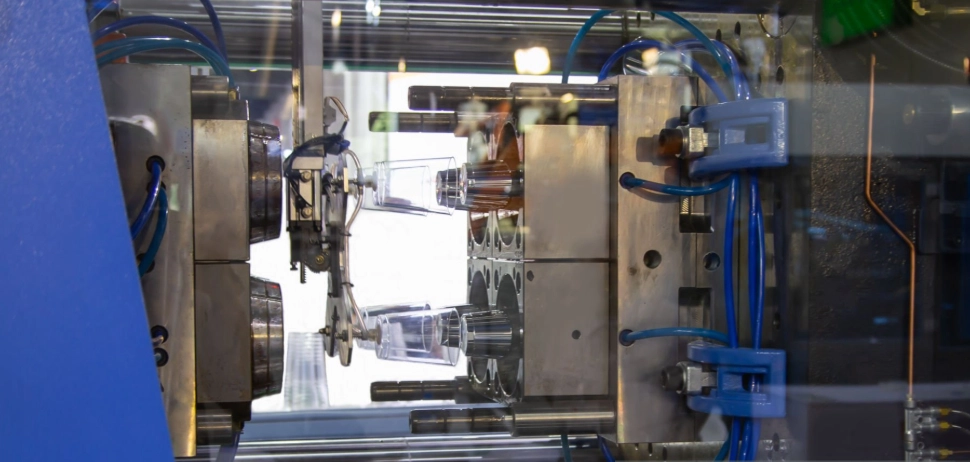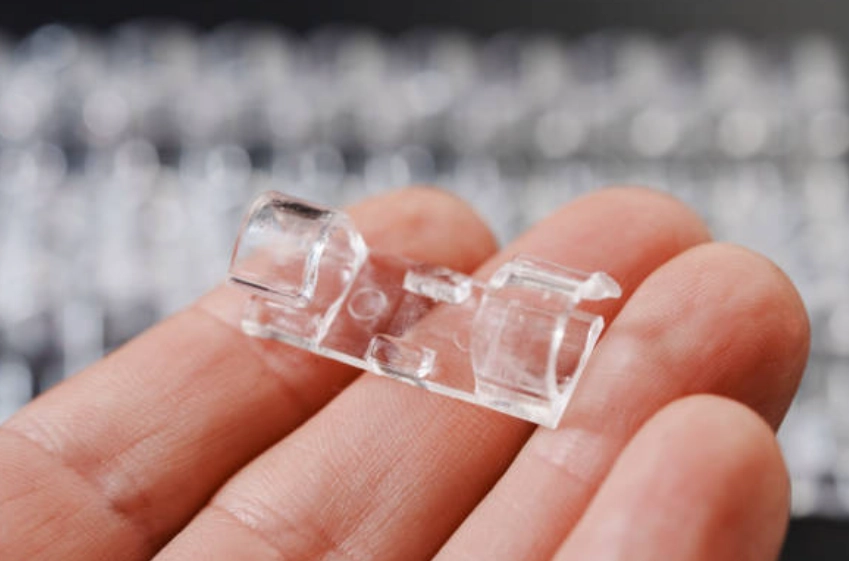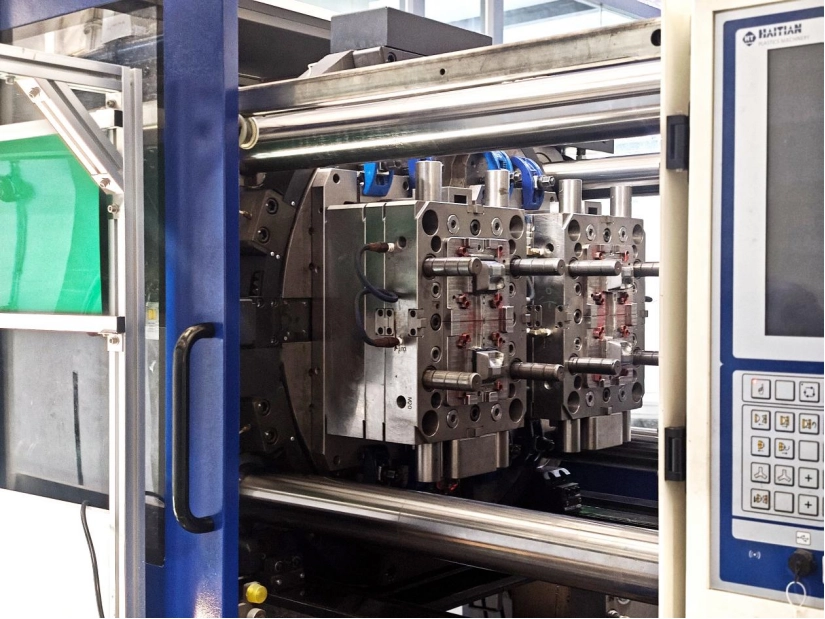Materials Options for Translucent and Clear Injection Molding
Acrylic (PMMA)
Acrylic can be molded into very clear and colored plastic items. It is safe, resists scratches, and blocks UV rays. This makes it a top pick for outdoor gear. Acrylic accepts dyes well. This suits it for lenses, lights, and items needing sharp visuals. However, acrylic is stiff and can break under strong force. Also, it soaks up water. It needs drying before molding. This can slow production.
High-density Polyethylene (HDPE)
High-density polyethylene (HDPE) resists UV rays like acrylic. It is easily molded into translucent plastic. HDPE is less fragile than acrylic. It is cheaper to make. These traits make it good for bottles and pipes. But HDPE lacks strength for heavy pressure.
Polycarbonate (PC)
Polycarbonate is another option for clear plastic injection molding. It is as see-through and UV-resistant as acrylic. It handles extreme heat and cold better. Its high impact strength makes it great for safety gear like helmets and goggles. Yet, polycarbonate absorbs water. It must be dried before molding.
Polyetherimide (PEI)
Polyetherimide (PEI) resists UV rays, intense heat, repeated force, and acids. These qualities make it fit for aerospace engine parts, heat sensors, shields, medical tools, and car parts. However, it needs steel molds. This raises production costs.
Polypropylene (PP)
Polypropylene (PP) is often used in fabrics, packaging, and containers. Its great flexibility makes it ideal for waterproof bags and clothing. It has strong electrical resistance for electronics. It also resists acids and bases. PP’s flexibility works well for moving hinges on light parts.
Liquid Silicone Rubber (LSR)
Liquid silicone rubber (LSR) is a safe, two-part material. It resists heat, chemicals, and electricity well. It offers excellent translucency for optical uses.
Optical Silicone Rubber (OLSR)
Optical silicone rubber (OLSR) allows up to 94% light to pass through. It beats materials like polycarbonate or acrylic in clarity. It resists yellowing from UV rays. It supports various shapes without losing strength.
Most Popular Materials for Injection Molding
The top materials for clear plastic injection molded parts include Acrylic and Polycarbonate. These depend on needed impact strength. LSR is used for optical needs. PETG is chosen for toughness. PP suits flexibility needs. HDPE is a budget-friendly choice. PEI is used where heat resistance is vital. MABS offers clarity with strength like ABS resin.
Light Transmissivity Through Popular Materials
Light transmissivity shows how much light passes through a material:
- Glass reaches 95% transmissivity.
- Optical LSR is close at 94%.
- Acrylic provides 93% transmissivity.
- Polypropylene gives about 90%.
- Polycarbonate ranges from 88% to 90%.
- Polyetherimide offers 82%.
- High-density polyethylene is around 80%.
Choose the Best Surface Finish for Optimal Clarity
To get the best clarity in translucent or clear plastic parts:
- SPI-A2 surface finish is the top standard. It works well for prototypes or small optical projects.
- Hand sanding or polishing suits simple designs. It can be costly, though.
- Resin coating gives great results on flat surfaces like windows or lenses.
To avoid flaws during production:
- Keep wall thickness even across parts.
- Use smooth transitions instead of sharp corners.
- Keep mold surfaces very smooth with low roughness.
- Clean equipment well to avoid impurities.
- Run mold flow tests to spot issues like weld lines or air bubbles.
By picking the right materials like PMMA or OLSR based on project needs and following strict design rules, you ensure success. This applies to making translucent and clear plastic parts using injection molding.
Design Tips for Clear or Translucent Parts
When designing clear or translucent parts, even wall thickness is crucial. Uneven walls can cause flaws like sink marks. These appear as dips on the surface due to uneven cooling. This is especially important in transparent molding. Looks matter greatly here.
Use wide and sturdy gate runners. They ensure smooth material flow. This reduces flow lines and weld lines. Choose gate locations carefully based on how the part shrinks. This lowers stress during cooling. Avoid sharp corners. Use smooth, gradual transitions instead. For example, polycarbonate (PC) parts must avoid gaps. Gaps can weaken structure and clarity.
The mold surface must be very smooth. Roughness should be less than 0.8 microns for clear results. Uneven cooling can cause surface flaws and damage. Precise temperature control during molding is vital. Run a mold flow test before production. It helps spot issues like air bubbles or weld lines. It also allows tweaking gate and part designs.
Surface Finish Considerations
The top standard for surface finish in clear plastic parts is SPI-A2. It is great for prototypes or small optical projects where clarity is key. For flat parts like windows or lenses, resin coating works well. Hand sanding and polishing suit simpler designs. They take time, though.
To avoid flaws from impurities, clean all equipment before use. Contaminants can cause surface peeling, silver streaks, or color changes. These are very noticeable in transparent parts.
Silkbridge Plastic Injection Molding Services
Silkbridge offers expert plastic injection molding services. These are tailored for translucent and clear plastic parts. Clear plastic molding needs extra care in design and production. Transparent plastics show all flaws and impurities. Every step must be precise, from choosing materials to final production.
Our skills cover popular materials like acrylic (PMMA), polycarbonate (PC), high-density polyethylene (HDPE), and polyetherimide (PEI). Each material has unique traits for specific uses. For example:
- Acrylic offers great clarity and UV resistance. It may need drying due to water absorption.
- Polycarbonate has high impact strength. It works well in extreme temperatures. It also needs pre-drying.
- HDPE is affordable and easily translucent. It lacks strength for high-pressure uses.
- PEI resists intense heat, pressure, and chemicals. It suits aerospace and medical uses.
We also use advanced materials like liquid silicone rubber (LSR) and optical silicone rubber (OLSR). These are for projects needing high translucency or light transmission. OLSR allows up to 94% light transmission. It is perfect for lighting or optical parts.
Our services focus on precision at every step:
- Material Preparation: We keep raw materials free from impurities. Proper storage and handling help.
- Mold Design: We add features like venting slots to avoid air traps. We ensure even wall thickness.
- Injection Process Tuning: We adjust settings like barrel temperature, injection speed, and pressure. This reduces internal stress.
By following these steps closely, we deliver high-quality translucent parts. They meet strict look and function standards.
FAQ
What are the most popular materials used in clear plastic injection molding?
Top materials include acrylic (PMMA), polycarbonate (PC), HDPE, PEI, polypropylene (PP), LSR, and OLSR. Each offers unique benefits based on the project’s needs for clarity, strength, UV resistance, or flexibility.
How do I choose the right material for my project?
Choosing a material depends on factors like strength, UV resistance, temperature range, shrinkage, chemical resistance, and electrical insulation. Talking to a skilled provider like Silkbridge helps. They can pick the best option for your project.
What are common defects in clear plastic injection molding?
Common flaws include flow lines from uneven material flow, sink marks from uneven cooling, surface peeling from contaminants, weld lines around holes, warping from uneven mold cooling, and silver streaks from trapped water or gas bubbles.
How can I ensure optimal clarity in my molded parts?
To get the best clarity:
- Use a high-quality surface finish like SPI-A2.
- Keep wall thickness even across parts.
- Design smooth transitions to avoid sharp corners.
- Run thorough mold flow tests before production.
- Clean equipment to prevent contamination.
Why choose Silkbridge for clear plastic injection molding?
Silkbridge is a manufacturing company that specializes in providing high-quality manufacturing solutions, combining British innovation with Chinese manufacturing efficiency. Founded in 2014 by a British design engineer, it is based in Guangdong Province, China12. Silkbridge aims to offer a one-stop-shop service, simplifying complex manufacturing projects for its customers
Silkbridge blends technical skill with modern facilities. They deliver excellent results in clear plastic molding projects. Their team excels at choosing the right materials for project needs. They also optimize designs to avoid flaws.
- WhatsApp: +86 18122838771
- Phone: +86 18122838771
- Email:contact@silkbridgeltd.com





